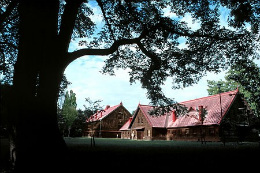Overview
 Sapporo Agricultural College (the present-day Hokkaido University) was established in 1876. Around the same time, a large farm was opened under the leadership of W. S. Clark, creating a hub for integrating modern large-scale agriculture, including livestock, which the residents of Hokkaido had no experience of.
Sapporo Agricultural College (the present-day Hokkaido University) was established in 1876. Around the same time, a large farm was opened under the leadership of W. S. Clark, creating a hub for integrating modern large-scale agriculture, including livestock, which the residents of Hokkaido had no experience of.
Clark’s program was inherited by W. P. Brooks, one of his former students at the Massachusetts Agricultural College. Brooks chose and imported crops and farming tools to use in cultivating Hokkaido, providing guidance on crops and operations; in this way, he made a great contribution to the development of a Hokkaido method of farming.
Sapporo Agricultural College’s Farm No. 2 began as a working model farm. It included a house for the livestock farmer, as well as facilities for livestock operations. These included a barn designed by W. Wheeler (built in 1877) and a feed storehouse designed by W. P. Brooks.
These farm facilities were built in the “balloon frame” style. They are practical buildings with a light wooden frame that was popular in the Midwestern United States at the time. The first floor of the model livestock barn is devoted to cattle stalls, while the expansive second floor is a hayloft. The model barn was intended to promote dairy farming, in accordance with Hokkaido’s climate.
In addition, the silo (built in 1912) is said to be the oldest farm structure in Hokkaido. Together with the other buildings, it is an important source of information about dairy farming operations of that period.
Information
Hours of operation: The facilities are generally open from April 29–November 3. They are closed on the 4th Monday of every month.
The grounds are open from 8:30 to 17:00.
The buildings are open from 10:00 to 16:00 (the model livestock barn, feed storehouse, and cattle shed)

